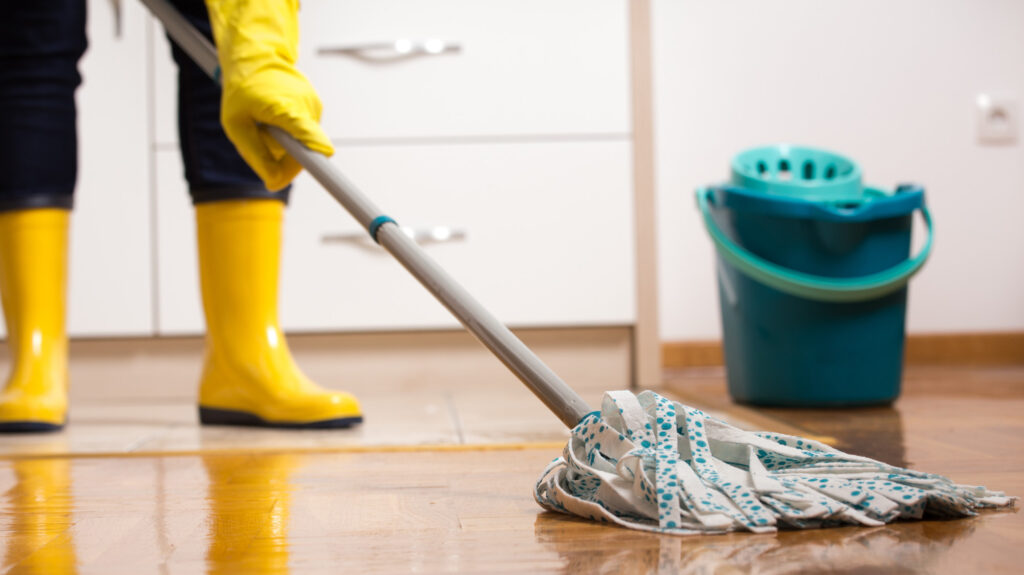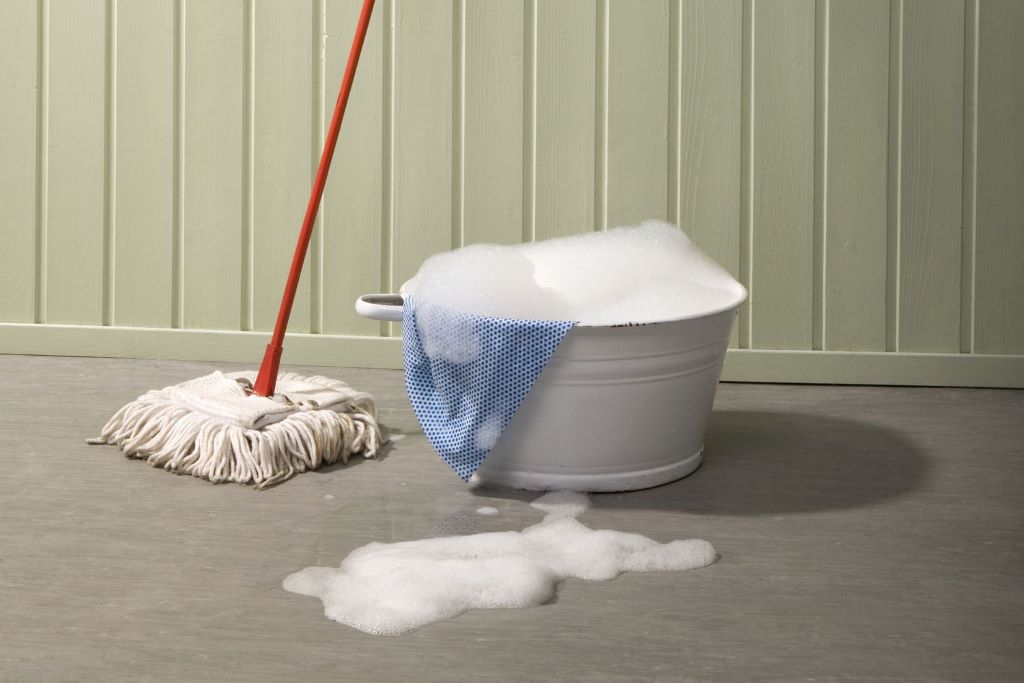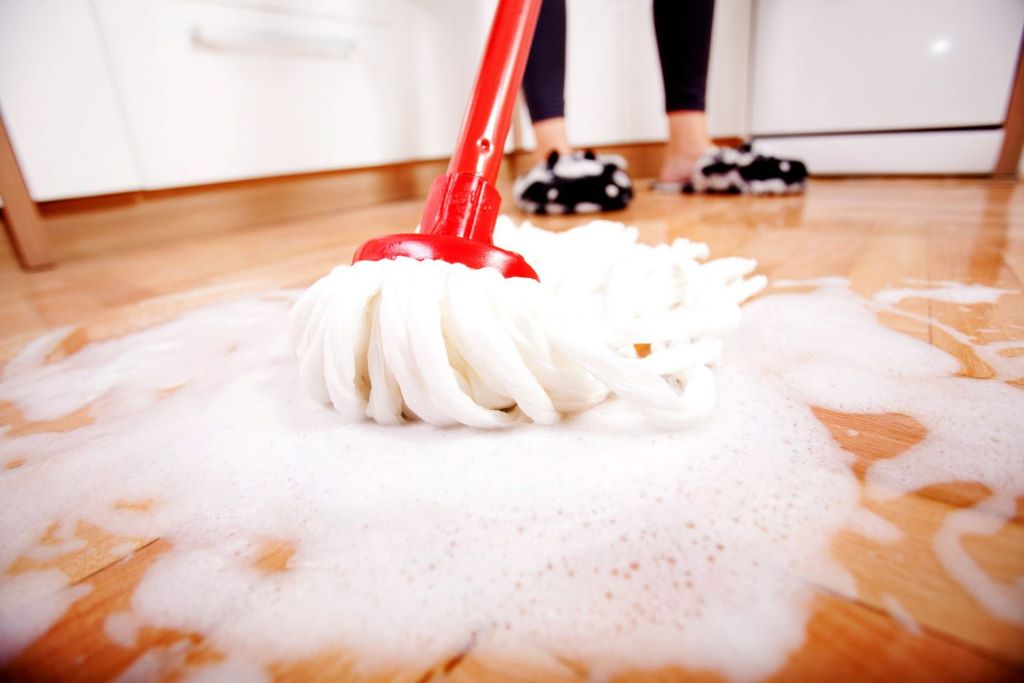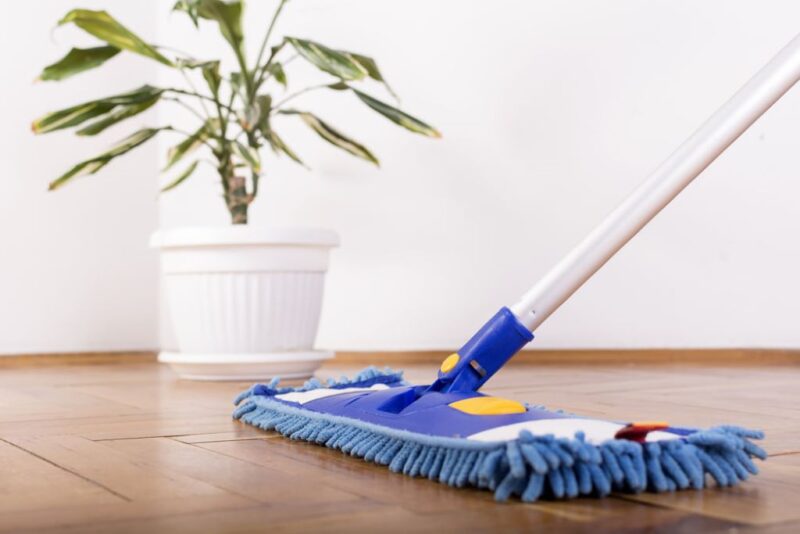Keeping floors clean is essential to maintaining a healthy and tidy home, and mopping the floor is one of the most effective ways to achieve this. However, many people are unsure of what the term “mop the floor” means or the best way to go about it. Essentially, mopping the floor involves using a combination of water and cleaning solutions to remove dirt, grime, and other contaminants from the floor surface.
This process typically involves wetting a mop and using it to spread the cleaning solution over the floor, before using the same mop to scrub away any stubborn stains or dirt. To get the best results, it’s important to choose the right type of mop and cleaning solution for your floor type, as well as to follow proper techniques to avoid leaving streaks or damaging the floor. This article will provide a complete overview of mopping floors, from what it means to tips and techniques.
What Is Mopping the Floor?

Mopping the floor refers to cleaning hard floor surfaces like tile, vinyl, laminate, hardwood, concrete, etc. using a mop and bucket. The basic process involves wetting a mop head with water and cleaning solution, wringing out excess liquid, and systematically mopping the floor’s surface to remove dirt, grime, spills, and tracked-in debris.
The goal of mopping is to thoroughly clean the floor without leaving behind streaks, sticky spots, or standing water. No matter how much I mop the floor it’s still dirty. Properly mopped floors should be free of dirt and debris, have a uniform clean appearance when dry, and not be slippery or sticky to walk on.
Why Mopping Is Important
Mopping serves several important purposes:
- Removes dirt and debris – Sweeping or vacuuming can remove loose dirt and debris from floor surfaces, but mopping with a cleaning solution is necessary to thoroughly clean and sanitize floors. Mopping lifts stuck-on messes and contaminants.
- Eliminates bacteria and germs – Mopping with a cleaning solution designed to kill bacteria sanitizes floors and reduces germs that can spread disease and illness.
- Leaves floors with a clean appearance – Mopping removes stuck-on grime to leave floors looking uniformly clean. It removes dulling filth, scuffs, sticky messes, and buildup.
- Makes floors safer to walk on – Getting floors really clean helps prevent slips and falls. It removes grease, sticky spots, and other hazards.
Regular mopping is essential for health, and safety, maintaining floor quality, and making living and work spaces look their best. For most homes, mopping 1-3 times per week is ideal. High traffic areas may need daily or twice daily mopping.
How to Mop the Floor Step-By-Step
Gather supplies:
- Bucket – Use 2 buckets for the double-bucket mopping method
- Mop – String mops or spin mops work best
- Mop head – Microfiber or cotton work well
- Cleaner – Use an all-purpose floor cleaner or soap-based cleaner
- Floor sign or caution sign (optional)
Prepare the cleaning solution:
- Fill bucket with warm water – For a stronger solution, use hot water
- Add floor cleaning concentrate per label instructions
- Give water and concentrate a brisk stir to mix thoroughly
Prepare the mop:
- Submerge mop head in cleaning solution to wet it thoroughly
- Wring mop until damp but not sopping wet
Mop the floor:
- Place floor sign to prevent slips if needed
- Start in the furthest corner of the room away from exits
- Use overlapping strokes and figure 8 motions to mop
- Rinse mop and re-wet frequently, at least once per small room
- Change cleaning solution once it gets very dirty
- Let floor air dry completely – Avoid walking on damp floors
Finish up:
- Rinse out equipment and allow to dry
- Wash mop heads regularly or replace disposable pads
- Put supplies away neatly until next use
The Double-Bucket Method
The double-bucket method helps lead to better mopping results by keeping cleaning solution cleaner. It prevents the mop from being dunked back into dirty water, reducing streaking.
How it works:
- Fill one bucket 1/2 way with cleaning solution (the “wash bucket”)
- Fill second bucket with clean rinse water (the “rinse bucket”)
- Dip and wring mop in wash bucket before mopping
- After mopping a section, dip mop into rinse bucket, swirl and wring
- Re-dip mop in clean wash bucket solution and continue mopping
This keeps the mop free of particles that can create streaks and buildup. Buckets with built-in rollers or spin mops make wringing easier.

Tips for Effective Mopping
Follow these tips for clean, streak-free floors:
- Sweep or vacuum floors first to remove loose debris
- Use only damp mops – Overly wet mops spread dirty water
- Work in sections so cleaning solution stays clean
- Rinse mops frequently and re-wet in fresh solution
- Use overlapping figure 8 strokes
- Go slow and be thorough for coverage
- Remove scuffs manually or use a stiff-bristle hand brush
- Allow floors to dry completely before walking on them
- Hang mops vertically to dry thoroughly after use
Switch out cleaning solution often and whenever it looks too dirty. For tough messes, let solution soak for 5 minutes before mopping.
Supplies Needed for Mopping Floors
Having the right mopping tools helps ensure clean, streak-free floors:
- Mops – String mops, spin mops, and flat microfiber pad mops all work well. For big areas, wider mop heads speed up mopping.
- Mop buckets – At least one bucket is needed to hold cleaning solution. Dual buckets make rinsing simple. Buckets with rollers simplify wringing out mops.
- Mop heads – Look for microfiber, cotton, or blended-material mop heads. Disposable pads are convenient but less eco-friendly.
- Cleaning solutions – All-purpose cleaners or floor-specific mixes work well. Diluted vinegar can be an effective natural option too.
- Floor sign – Keeps others from walking on wet floors. Helpful for commercial spaces.
- Gloves – Protect hands and give a better grip. Durable rubber gloves are reusable.
- Stiff brush – Handy for scrubbing tough spots and around baseboards.
- Squeegee – Quickly removes standing water for fast drying. Especially useful on tile floors.
How to Clean Different Types of Floors
Technique and cleaning solutions may vary slightly by flooring type:
Tile and Stone Floors
- Use all-purpose cleaner or stone-safe mixes
- Grout may need scrubbed with a stiff brush
- Rinse thoroughly and dry with a squeegee
Hardwood Floors
- Use only small amounts of mild soap-based cleaners
- Avoid getting floors overly wet
- Damp mop in direction of wood grain
- Dry immediately with towels
Laminate and Luxury Vinyl Floors
- All-purpose cleaners work well
- Avoid abrasive brushes or scouring pads
- Don’t use excessive water
- Dry quickly to avoid possible floor damage
Concrete Floors
- Scrub with stiff-bristle brush and pH-neutral detergent
- Rinse thoroughly – avoid alkaline cleaner buildup
- Let dry fully before walking on surface
Adjust technique based on flooring type and manufacturer instructions. Test cleaners on inconspicuous spots first.
Mopping vs. Sweeping or Vacuuming
Sweeping and vacuuming both serve a different purpose than mopping:
- Sweeping – Removes loose debris and surface dust. Not sufficient for sanitizing or removing stuck-on grime.
- Vacuuming – Uses suction to pick up dry debris. Usually not effective on spills or sticky, stuck-on messes.
- Mopping – Actually cleans floor surfaces using wet friction and cleaning solutions. Removes stuck-on dirt and sanitizes floors.
Sweeping and vacuuming should be done first before mopping to remove loose debris. But mopping is still needed after sweeping or vacuuming for a full cleaning.
For best results, sweep or vacuum first, mop second. This prevents pushing around loose debris while mopping and improves mopping effectiveness.
When to Mop Floors
Mopping frequency depends on traffic volume and how quickly floors get dirty:
- High traffic areas – Daily or twice daily mopping. Examples: entryways, kitchens, bathrooms.
- Moderate traffic areas – 2 to 3 times per week. Examples: dining rooms, common living areas.
- Low traffic areas – Weekly mopping. Examples: bedrooms, offices, finished basements.
Also mop when:
- Spills occur
- Heavy debris tracks in
- Floors appear dull or dirty
- Seasonal deep cleaning
Inspect floors periodically to see if mopping is needed. Dirtier floors may require rinsing and scrubbing instead of just mopping.
Mopping Wood Floors vs Other Floors
Mopping wood floors requires more care than other hard floors:
- Use only finish-safe cleaners to avoid damaging protective coatings. Avoid alkaline, acidic, or abrasive cleaners.
- Minimize water use. Damp mop only – excess moisture can damage wood.
- Always mop with the direction of the floorboards to avoid streaking.
- Dry immediately with a clean cloth. Prolonged moisture exposure harms wood.
- Do not scrub or use stiff-bristled brushes. Only soft microfiber mops.
Other floors like tile, vinyl and concrete are more durable and tolerant of vigorous scrubbing, harsher detergents, and being wet for longer. Take extra care when mopping hardwood.
Common Mopping Mistakes to Avoid
Some common mopping errors lead to subpar cleaning and possible floor damage:
- Using too much cleaning solution – Overly wet floors take longer to dry
- Not wringing out mops thoroughly – Leaves excess dirty water
- Skipping the prep sweep or vacuum – Pushes around loose debris
- Mopping in a random pattern – Leads to missed spots and streaks
- Not rinsing and re-wetting mops – Spreads around dirty solution
- Letting floors air dry too long – Risks someone walking over damp floors
- Using dirty cleaning solution for too long – Reduces cleaning effectiveness
- Pressing down too hard while mopping – Can damage floors over time
- Not following flooring manufacturer guidelines – Risks harm from wrong cleaners
Avoiding these common mistakes helps ensure mopping cleans floors effectively and safely.
Mopping Efficiently in Large Spaces
Mopping large spaces like warehouses, retail stores, schools, and churches requires a systematic approach:
- Use wider mops and buckets-on-wheels to cover more ground quickly
- Section off and mop one area at a time to keep cleaning solution clean
- Use floor signs liberally to prevent slips on wet floors
- Double bucket and spin mops simplify rinsing and wringing
- Start farthest from main doors and work your way out
-Have extra cleaning solution and mop heads ready for fast re-supply
- Work in a team for big rooms – divide the mopping up
- Allow extra drying time before re-opening to foot traffic
Proper mopping in large spaces prevents falls, keeps floors hygienic for occupants, and maintains floor appearance.
Is Mopping the Best Way to Clean Floors?
Mopping is one of the most effective methods for cleaning floors thoroughly:
Pros
- Removes stuck-on contaminants that sweeping or vacuuming cannot
- Cleans and disinfects floors for better hygiene
- Restores floor appearance by removing dulling dirt and buildup
- Wet friction helps remove tough spots other methods miss
- Simple enough for regular cleaning maintenance
Cons
- Takes more physical effort than automated methods like robot vacuums
- Wet floors take time to dry before walking on them
- Improper mopping can damage some floor types
- Not as deep-cleaning as periodically scrubbing floors on hands and knees
For regular floor care, mopping provides an optimal balance of convenience and deep cleaning ability. Automated scrubbers are another option for large commercial spaces. Overall, mopping remains one of the most reliable and effective floor cleaning methods.
Mopping Floors vs Hiring a Cleaning Service
DIY Mopping:
- Very affordable using basic supplies – great for limited budgets
- Allows custom cleaning frequency and methods
- Provides exercise and sense of household accomplishment
Professional Cleaning Services:
- Convenient, saves time and effort
- Workers are experienced with best practices
- Industrial equipment cleans better than basic DIY
- Frees up free time for other priorities
Verdict:
For those short on time, hiring a cleaning service can be worthwhile for routine deep mopping. But basic DIY mopping allows frequent spot mopping at low cost. Combining DIY whole-home mopping 1-2 times monthly with weekly DIY touch-up spot mopping provides a good balance.
Mopping Floors with Vinegar
Vinegar makes an effective natural floor cleaner because:
- Cuts grease – Vinegar dissolves greasy residues
- Disinfects – Has antimicrobial properties that kill bacteria
- Deodorizes – Removes odors instead of just masking them
- Non-toxic – Safer for humans and pets than many cleaners
How to mop with vinegar:
- Mix 1 cup vinegar per gallon of warm water
- For tough messes, use straight vinegar
- Mop as usual with vinegar solution
- Rinse with plain water to avoid sticky residue
- Allow floors to dry completely
Vinegar is safe for most floor types. It provides an affordable eco-friendly cleaning option. Baking soda can be combined with vinegar for added cleaning power.
Is Mop and Glo Good for Floors?

Mop and Glo is a popular floor cleaner that both mops and adds a glossy shine to floors. However, there are some downsides:
Pros:
- Convenient all-in-one mopping and shine
- Pleasant scent
- Leaves a glossy finish
Cons:
- Leaves a residue that requires thorough rinsing
- Contains petroleum solvents some consider unhealthy
- Gloss makes floors slippery
- Not compatible with all floors
The verdict:
Mop and Glo help clean and shine floors. But separate mopping and polishing may be a safer approach for floors and health. Mop and Glo is also not ideal for floors like hardwood that should not have glossy coatings.
Steam Mop vs Regular Mop
Steam mops use heated steam to sanitize and clean bare floors. Regular mops use manual friction and cleaning solutions.
Steam mop pros:
- Disinfects floors without chemicals
- Heated steam degreases and cuts grime
- Convenient steam on demand
Regular mop pros:
- No electricity required
- Cheaper upfront costs
- Works on any floor type
- Scrubs tougher with manual friction
Steam mops excel at sanitizing and are a bit faster. But they have higher upfront costs, require power, and aren’t compatible with all floors. Manual mops provide vigorous scrubbing action. For optimal results, steam mopping can be combined with occasional regular mopping.
Conclusion
Mopping floors entails carefully cleaning hard surface flooring with a wet mop. It lifts dirt, eliminates bacteria, restores appearance, and prevents slips. Effective mopping takes the right supplies and technique tailored to each floor type. Following best practices prevents streaks and buildup.
While not deep-cleaning like scrubbing, mopping removes surface contaminants sweeping and vacuuming leave behind. It is an essential part of any floor cleaning regimen. Proper mopping improves safety, health, and aesthetics – helping provide welcoming, hygienic spaces.
Frequently Asked Questions
What is the best way to mop floors?
Use the double bucket method – one bucket for clean solution and one for rinsing. Mop in overlapping Figure-8 strokes. Work in sections and change rinse water frequently to avoid spreading dirty solution.
How often should you mop floors?
High traffic areas like kitchens and bathrooms should be mopped daily or several times a week. Moderate traffic floors can be mopped 2-3 times per week. Low traffic floors only need mopping weekly.
What is the best mop for floors?
For most homes, a simple string mop or spin mop with a microfiber head is ideal. Commercial floors benefit from wide flat mops and rolling buckets. Hardwood floors require gentle microfiber heads.
What is the best cleaner for mopping floors?
All-purpose cleaners or diluted vinegar work well for most tile, laminate, and vinyl. Use only specialty hardwood cleaners approved for your floors finish. Avoid excessive water.
Can you use bleach when mopping floors?
Yes, diluted bleach can sanitize floors and remove stains and discoloration. But overuse damages many floors. Only use bleach occasionally and rinse thoroughly. Never mix bleach and vinegar.
Mopping floors regularly is one of the most effective ways to remove grime and have cleaner, safer flooring. Care tips for polished marble floors: Following proper mopping techniques is essential for maintaining the pristine appearance of polished marble floors, ensuring they look their best and contributing to the overall health of homes and facilities through consistent upkeep.

